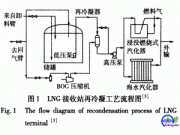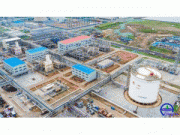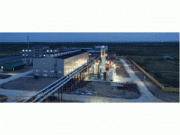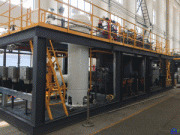免职声明:本网站为公益性网站,部分信息来自网络,如果涉及贵网站的知识产权,请及时反馈,我们承诺第一时间删除!
This website is a public welfare website, part of the information from the Internet, if it involves the intellectual property rights of your website, please timely feedback, we promise to delete the first time.
电话Tel: 19550540085: QQ号: 929496072 or 邮箱Email: Lng@vip.qq.com
摘要:液化天然气常识! What is LNG? Where does LNG come from? What countries import LNG? Where are LNG terminals located in the United States? How is LNG transported? How is LNG stored? How is natural gas stored? How is LNG used? Why use LNG? Is LNG flam..
液化天然气常识! 液化天然气常识!
What is LNG? Liquefied natural gas, or LNG, is natural gas in its liquid form. When natural gas is cooled to minus 259 degrees Fahrenheit (-161 degrees Celsius), it becomes a clear, colorless, odorless liquid. LNG is neither corrosive nor toxic. Natural gas is primarily methane, with low concentrations of other hydrocarbons, water, carbon dioxide, nitrogen, oxygen and some sulfur compounds. During the process known as liquefaction, natural gas is cooled below its boiling point, removing most of these compounds. The remaining natural gas is primarily methane with only small amounts of other hydrocarbons. LNG weighs less than half the weight of water so it will float if spilled on water. Where does LNG come from? A majority of the world's LNG supply comes from countries with large natural gas reserves. These countries include Algeria, Australia, Brunei, Indonesia, Libya, Malaysia, Nigeria, Oman, Qatar, and Trinidad and Tobago. What countries import LNG? There are 40 LNG receiving terminals located worldwide. Japan, South Korea, the United State and a number of European Counties import LNG. Where are LNG import terminals located in the United States? LNG terminals in the United States are located in Everett, Massachusetts; Cove Point, Maryland; Elba Island, Georgia; and Lake Charles, Louisiana; and Peñuelas, Puerto Rico. How is LNG transported?
How is LNG stored?
How is natural gas stored? Natural gas may be stored in a number of different ways. It is most commonly stored underground under pressure in three types of facilities. The most commonly used in California are depleted reservoirs in oil and/or gas fields because they are more available. Aquifers and salt cavern formations are also used under certain conditions. The characteristics and economics of each type of storage site will dictate its suitability for use. Two of the most important characteristics of an underground storage reservoir are its capability to hold natural gas for future use and its deliverability rate. The deliverability rate is determined by the withdrawal capacity of the associated valves and compressors and the total amount of gas in the reservoir. In other states, natural gas is also stored as LNG after the natural gas has been liquefied and placed in above-ground storage tanks. (Source: U.S. Department of Energy, Energy Information Administration.) How is LNG used? LNG is normally warmed to make natural gas to be used in heating and cooking as well as electricity generation and other industrial uses. LNG can also be kept as a liquid to be used as an alternative transportation fuel. Why use LNG? Natural gas is the cleanest burning fossil fuel. It produces less emissions and pollutants than either coal or oil. The North American supply basins are maturing and as demand for natural gas increases in California and throughout the United States, alternative sources of natural gas are being investigated. Natural gas is available outside of North America, but this gas is not accessible by pipelines. Natural gas can be imported to the United States from distant sources in the form of LNG. Since LNG occupies only a fraction (1/600) of the volume of natural gas, and takes up less space, it is more economical to transport across large distances and can be stored in larger quantities. LNG is a price-competitive source of energy that could help meet future economic needs in the United States. Is LNG flammable?
Is LNG explosive? As a liquid, LNG is not explosive. LNG vapor will only explode if in an enclosed space. LNG vapor is only explosive if within the flammable range of 5%-15% when mixed with air. What is a Rapid Phase Transition? When enough LNG is spilled on water at a very fast rate, a Rapid Phase Transition, or RPT, occurs. Heat is transferred from the water to the LNG, causing the LNG to instantly convert from its liquid phase to its gaseous phase. A large amount of energy is released during this rapid transition between phases and a physical explosion can occur. While there is no combustion, this physical explosion can be hazardous to any nearby person or buildings. What about security? All LNG ships must comply with all pertinent local and international regulatory requirements, which include regulations and codes set forth by the International Maritime Organization (IMO), the U.S. Maritime Administration (MARAD), the U.S. Coast Guard (USCG), and the U.S. Department of Transportation (DOT), as well as the hosting Port Authority. DOT regulations must be followed at onshore LNG facilities and marine terminals. The Research and Special Programs Administration, DOT, regulations include 49 CFR Part 193 - Liquefied Natural Gas Facilities: Federal Safety Standards. These standards specify siting, design, construction, equipment, and fire protection requirements that apply to new LNG facilities and to existing facilities that have been replaced, relocated, or significantly altered. Offshore marine terminals must follow regulations set by the USCG. The USCG monitors the safety of coastal waters around the U.S. and ensures the safety of ships while in U.S. waters and in port by preventing other ships from getting near LNG tankers. The USCG works with local harbor authorities and LNG facility personnel to ensure that proper procedures are followed. The USCG and MARAD are the federal agencies responsible for siting off-shore LNG facilities and are currently developing regulations. What is a "peak-shaving" facility? LNG peak-shaving facilities are used for storing surplus natural gas that is to be used to meet the requirements of peak consumption later during winter or summer. Each peak-shaving facility has a regasification unit attached but may or may not have a liquefaction unit. These facilities without a liquefaction unit depend upon tank trucks to bring LNG from other nearby sources to them. Of the approximate 113 active LNG facilities in the United States, 57 are peak-shaving facilities. The other LNG facilities include marine terminals, storage facilities, and operations involved in niche markets such as LNG vehicular fuel. (Source: University of Houston IELE, Introduction to LNG .) Please see map of U.S. facilities.
|




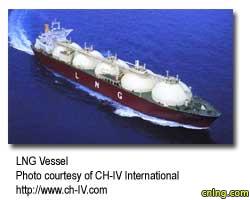 LNG is transported in double-hulled ships specifically designed to handle the low temperature of LNG. These carriers are insulated to limit the amount of LNG that
LNG is transported in double-hulled ships specifically designed to handle the low temperature of LNG. These carriers are insulated to limit the amount of LNG that 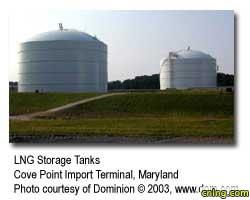 When LNG is received at most terminals, it is transferred to insulated storage tanks that are built to specifically hold LNG. These tanks can be found above or below ground and keep the liquid at a low temperature to minimize the amount of evaporation. If LNG vapors are not released, the pressure and temperature within the tank will continue to rise. LNG is characterized as a
When LNG is received at most terminals, it is transferred to insulated storage tanks that are built to specifically hold LNG. These tanks can be found above or below ground and keep the liquid at a low temperature to minimize the amount of evaporation. If LNG vapors are not released, the pressure and temperature within the tank will continue to rise. LNG is characterized as a 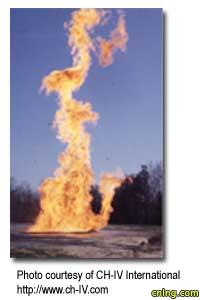 When cold LNG comes in contact with warmer air, it becomes a visible vapor cloud. As it continues to get warmer, the vapor cloud becomes lighter than air and rises. When LNG vapor mixes with air it is only flammable if it's within 5%-15% natural gas in air. If it's less than five percent natural gas in air, there is not enough natural gas in the air to burn. If it's more than 15 percent natural gas in air, there is too much gas in the air and not enough oxygen for it to burn.
When cold LNG comes in contact with warmer air, it becomes a visible vapor cloud. As it continues to get warmer, the vapor cloud becomes lighter than air and rises. When LNG vapor mixes with air it is only flammable if it's within 5%-15% natural gas in air. If it's less than five percent natural gas in air, there is not enough natural gas in the air to burn. If it's more than 15 percent natural gas in air, there is too much gas in the air and not enough oxygen for it to burn. 



